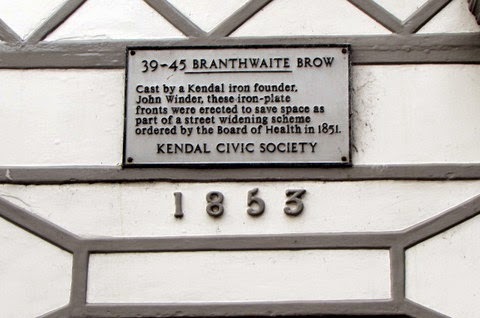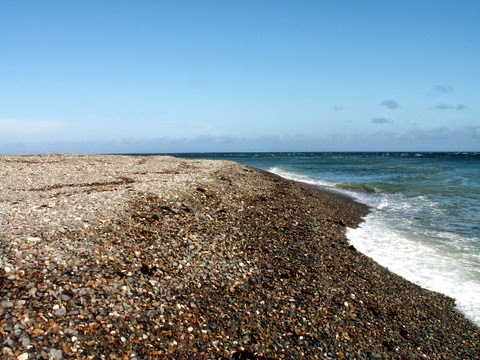CUMBRIA is probably best known as the Lakeland County with the larger part consisting of the Lake District National Park. The county came into being in 1974 when the former counties of Cumberland and Westmoreland, together with part of Lancashire, were amalgamated.
KIRKBY LONSDALE is a small market town of great antiquity in the extreme south-east and close to the border with North Yorkshire. This little country town, with a population of just under 2,000 people, developed at a crossing point of the River Lune which is crossed by a fine grit stone bridge known locally as the Devil's Bridge. The bridge dates to before 1272 when it was repaired and, despite the legend which surrounds it, was probably built by monks from St Mary's Abbey in York. By-passed in the 1930's, the bridge is Grade 1 listed
and a Scheduled Ancient Monument.
and a Scheduled Ancient Monument.
Legend
has it that the Devil met up with an old lady
who seemed to be somewhat upset. Apparently her cow had found its way across
the river and she was unable to get it back. It had been too difficult for
mortals to build a bridge at this spot, but The Devil told her that he would
build a bridge over the river for her on condition that he would be able to
keep the first living soul to cross his bridge and this was agreed. The next
day the old woman found that there was indeed a bridge but instead of crossing
it herself she sent her dog over instead
and so the Devil was thwarted and the bridge has been known as The Devil’s ever
since.
A plague stone at the south east corner of the bridge reads, "Fear God Honor the King 1633". It would have been placed there to contain vinegar when the plague was rampant in the 17th century, This enabled villagers to leave money in the vinegar in payment for goods to be left for them at that point.
The pretty River Lune flows to the east and north of the town.
and the vista from a view point near to the churchyard is known as
'Ruskin's View'. It was described by the 19th century art critic, John Ruskin as,
"One of the loveliest views in England."
'Ruskin's View'. It was described by the 19th century art critic, John Ruskin as,
"One of the loveliest views in England."
St Mary's Church is situated high above the river. Of Norman origin it is a
Grade 1 listed building.
Grade 1 listed building.
A gazebo in the north of the churchyard and close to Ruskin's View, was originally part of the vicarage garden.
The Market place at the centre of the town was formed in 1832.
The building at the rear, now a private residence, was built in 1818 to house a Savings Bank.
The Old Market Cross is now preserved in Swinemarket where it is surrounded by well restored buildings.
The Sun Hotel with its arcaded front is in the original Market Street. This is where the landlord traditionally read the London news-sheet aloud.
Along the Main Street and other areas of the town there are lots of little yards and alleyways. Salt Pie Lane, formerly Cattle Market Lane, is one which has a story to tell as related on a wall plaque.
ALLITHWAITE, formerly in Lancashire, is a small village in the south of the county overlooking the northern part of Morecambe Bay.
CARTMEL is a nearby village.
CARTMEL is a nearby village.
The curiously named Guide
Over the Sands Inn at Allithwaite reminds us of the ancient routes which actually cross over
the wide bay when the tide is out.
Before the advent of more efficient transport, it was quicker for people
to travel that way than overland.
However, the quicksands, shifting fogs and sudden tides, made the
crossing of these routes a dangerous business, indeed the Tidal Race, occurring
every 12 hours, can outrun a galloping horse.
Very few people can identify the safe paths across the sands when the
tide is out and eventually The Queen’s Official Guides to the Sands of
Morecambe Bay were appointed to
ensure the safe passage of travellers.
Every day the sands are
different as the sea washes away old tracks making the job of the guide
extremely hazardous. The official guide
still lives at Cartmell and his house is surrounded by laurel bushes whose
leaves he uses to mark the safe routes across the Bay. The appointment is funded by the Queen, as a
service to the public from the Duchy of Lancaster.It is still possible to make such walks to this day, but only the foolhardy would attempt such crossings without the guide!
An old signpost at nearby
Cartmel shows : Lancaster over-sands 15 miles
& Ulverston over-sands 7
miles.
FLOOKBURGH is a nearby fishing village where flounders are a particular part of the catch. They are known locally as 'flooks', from which the village derives its name. The weather vane on the church tower is in the
shape of a flook.
KENDAL, the gateway to the Lakes, is a bustling old market town on the River Kent. It is known as 'The Auld Grey Town' because of the distinctive limestone buildings.
The timber-framed Fleece Inn opposite the Town Hall dates to 1656
Two milestones outside the 18th c entury Highgate Hotel, in Highgate, tell us that it is 135 miles to Edinburgh and 258 miles to London. Apparently the milestones inspired a woman to walk from Highgate in Kendal to Highgate in London and to write a book about her adventures.
Now a Weatherspoon Inn, The Miles Thomson in All Hallows Lane was formerly the public wash house and bath.
The five aisled Parish Church dates to the 13th century.
This huge church is almost as wide as York Minster and has associations with Katherine Parr one of Henry V111 wives.
A 17th century helmet and sword hanging high up on the north wall inside the church, tell an unusual story and are said to have belonged to one 'Robin the Devil'. He was in fact Royalist, Sir Robert Phillipson who lived in a curious round house on Belle Isle, the largest island on Lake Windermere. During the English Civil War Belle Isle was besieged and bombarded by a Parliamentary troop led by a Colonel Briggs, a regular worshipper at Kendal church. The attack failed somewhat due to trees on the island which protected Phillpson's house and when the Parliamentarians departed Phillipson is said to have pursued Briggs to Kendal where he entered the church on horseback searching for his enemy. He was repelled and it is said that he lost his helmet and sword in the skirmish whilst making good his escape.
Millar Bridge over The River Kent dates to 1818

.jpg)


















.JPG)














%2B(5).JPG)
%2B(4).JPG)
.JPG)










.JPG)
.JPG)
.JPG)








.JPG)
.JPG)




.JPG)

.JPG)
.JPG)
.JPG)
.JPG)
.JPG)
.JPG)







